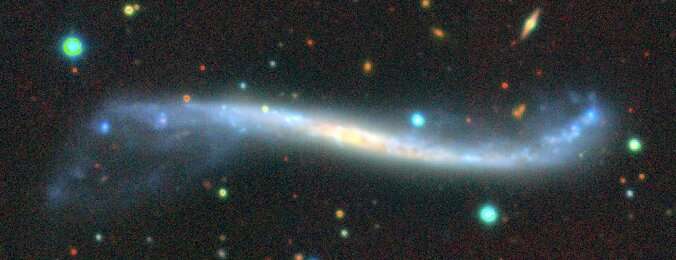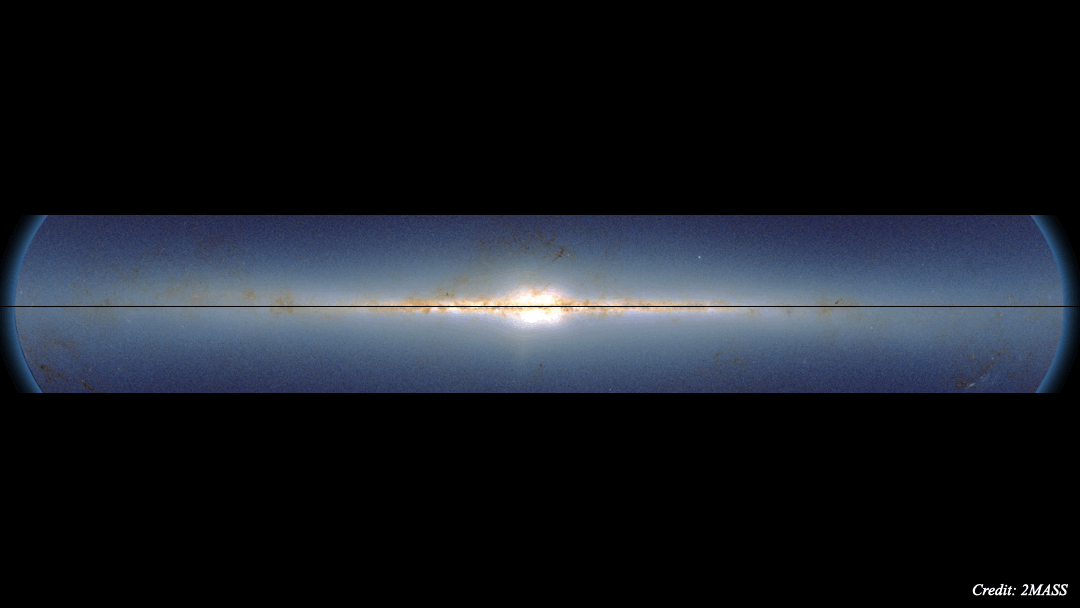The Milky Way does the wave

In results announced this week at the 237th Meeting of the American Astronomical Society, scientists from the Sloan Digital Sky survey present the most detailed look yet at the warp of our own galaxy.
"Our usual picture of a spiral galaxy is as a flat disk, thinner than a pancake, peacefully rotating around its center," said Xinlun Cheng of the University of Virginia, the lead author of the study. "But the reality is more complicated."
Astronomers have known for decades that many spiral galaxies actually have disks with a slight twist to them, like a potato chip or a vinyl record left out too long in the sun. Such twists occur in about 50 to 70% of spiral galaxies, including our own Milky Way.
Surprisingly, however, we do not know much about the warp in the Milky Way. Stuck deep inside it and limited to only a single perspective from Earth, we lack the ability to see our galaxy's warp in one look. Instead, we must trace out the shape of the warp by carefully studying the positions and motions of stars all over the Milky Way. That is exactly what the researchers did, and thanks to the Sloan Digital Sky Survey data, they were able to get a more detailed look than ever before, finding that not only is the galaxy's disk warped, the warp travels around the galaxy once every 440 million years.
"Imagine that you are in the stands at a football game, and the crowd starts doing the wave," Cheng says. "All you do is stand up and sit down, but the effect is that the wave goes all the way around the stadium. It's the same with the galactic warp—stars only move up and down, but the wave travels all the way around the galaxy."

To find this unexpected result, the team made use of the high-precision spectrograph of the Apache Point Observatory Galactic Evolution Experiment (APOGEE), part of Sloan Digital Sky Survey (SDSS). Over its almost 10 year lifetime, APOGEE has observed hundreds of thousands of stars in the Milky Way. It does so by collecting spectra, measurements of starlight split into its component wavelengths in much the same way as a prism splits light into a rainbow of colors.
"The APOGEE spectra provide information about the chemical makeup and motions of individual stars," explains Dr. Borja Anguiano of the University of Virginia, a coauthor of the study and mentor to Cheng.
"That allows us to separate them into different groups, which in turn allows us to follow the warp separately within each group of stars."
But the APOGEE spectra alone were not enough to understand the warp. Tracing the galactic warp requires extremely precise measurements of stellar distances. To get those distances, the team turned to data from the European Space Agency (ESA)'s Gaia satellite, which calculates the distances to millions of stars by measuring the tiny back-and-forth wobbles in the direction to the star as the Earth (and the satellite) orbits the Sun.
By combining the APOGEE and Gaia data, the team was able to create full three-dimensional maps of stars in the Milky Way, with detailed information about each star's position, velocity, and chemistry. Armed with these high-precision measurements, the team was capable of probing farther into the outer part of our galaxy to produce the most detailed study yet of this phenomenon.
The analysis showed how the warp is caused by the wave traveling through the Milky Way, causing individual stars to move up and down through the plane of the galaxy as it travels. The new study has measured the speed and extent of the wave more precisely than ever before.
The most likely explanation for the warp is that a recent interaction with a satellite galaxy created a gravitational ripple, and that ripple has continued to move through the galaxy, forming the wave. Cheng explains, "our best model is that there was an encounter with a satellite galaxy about 3 billion years ago—this is considered relatively recent by galactic astronomers."
Results like this show how dynamic and ever-changing galaxies are on astronomical timescales.
The excitement is just beginning for the Milky Way—in about four billion years, we are expected to collide with the Andromeda galaxy, an event which will change our galactic home forever.
Provided by Sloan Digital Sky Survey





















